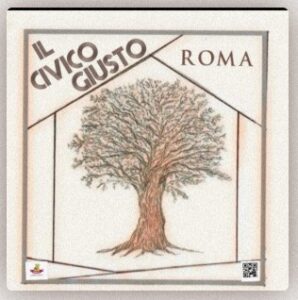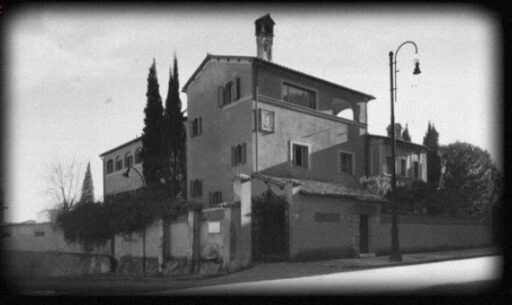
“Finora ci sono circa 25 ‘civici giusti’ e ne presenteremo tanti altri in quest’anno in cui ricorre l’ottantesimo Anniversario della Liberazione d’Italia. Con questo progetto – spiega Masini – coinvolgiamo una serie di artisti a cui chiediamo di prestarci la voce per raccontare queste storie, poi condivise tramite il QR code del civico giusto”. Corrado Augias, Luca Barbarossa, Elio Germano, Valerio Mastrandrea, Neri Marcorè, Enzo De Caro, Monica Guerritore, Angela Finocchiaro e tanti altri: attori e cantanti che danno il loro contributo per arricchire un progetto rivolto, anche e soprattutto, ai giovani. Per loro la rete di scuole “Memorie. Roma: una città, mille storie” coordinata dalla Dirigente Scolastica Maria Grazia Lancellotti promuove, in collaborazione con il Roma Best Practices Award, lo studio della storia della città, attraverso gli eventi e i protagonisti di una vicenda plurisecolare: da quelli più celebri, ma che per i giovani rimangono spesso confinati nelle righe di un libro, a quelli legati invece alla vita quotidiana dei quartieri, a coloro che li hanno abitati e che si sono trasformati in eroi ‘per caso’, proprio come chi nascose i perseguitati politici durante il nazifascismo. Da Villa Visconti dove trovarono riparo alcuni tra i più grandi protagonisti dell’Italia democratica, alla casa di Fondi che accolse Alberto Moravia ed Elsa Morante. Fino ad arrivare al Porto di Napoli che, sullo sfondo di una città distrutta dalla ferocia della guerra, racconta la storia a lieto fine di 982 rifugiati e della nave che li porterà negli Stati Uniti. Il progetto– annuncia Masini, che è anche il Presidente della Fondazione Museo Nazionale dell’Emigrazione Italiana – si allargherà, infatti, anche al mondo dell’emigrazione, a partire dalla storia di Cesidio Perruzza, originario di San Donato Val di Comino (Frosinone) ed emigrato a New York, che nel 1931 decise di celebrare il suo lavoro e quello dei tanti emigrati impegnati a costruire il grattacielo nel Rockefeller Center, con un albero di Natale che oggi è diventato il più famoso al mondo. Storie di emigrazione, sacrificio e successo che sono diventate negli anni un fermo punto di riferimento per i tanti italo-discendenti sparsi in tutto il mondo. “Il Civico Giusto” è quindi un progetto che, insieme a quello messo in campo dal Ministero degli Esteri sul Turismo delle Radici con Italea, vogliono essere un’occasione per scoprire le proprie origini, che quelle storie di emigrazione del secolo scorso contribuirono a costruire.
There was an Italy that did not look the other way: women and men who during Nazi-fascism risked their lives to welcome – and therefore save – partisans, Jews and politically persecuted. The “Il Civico Giusto” project wants to pay homage to them, heroic citizens who did not pretend not to see during one of the most dramatic moments for our continent. Born from an intuition of Paolo Masini and created by Roma Best Practices Award – Mamma Roma and her Best Children, the project aims to tangibly “mark and recognize” those houses that, thanks to the courage of the inhabitants, were the safe refuge of those who the Nazi-Fascists hunted. “The project stems from the need to tell the story of memory differently,” says Paolo Masini, president of Roma BPA. We are used to a memory of drama and tragedy, which does not allow young people to have a way out”. That’s why the idea of telling the “good” story that took place within those walls was born. What? With a “right number”: a tile to be affixed to the doors of the apartment buildings where hundreds of people have been hidden and saved from the roundups. On the sign – a brass plaque engraved with a carob tree, a symbol of abundance, made by Dante Mortet – there is a QR code that allows you to connect to a short documentary that tells the story of the building and the families protagonists of that story.” So far there are about 25 ‘civici giusti’ and we will present many more in this year in which the eightieth Anniversary of the Liberation of Italy occurs. With this project – explains Masini – we involve a series of artists to whom we ask to lend us their voices to tell these stories, then shared through the QR code of the right number “. Corrado Augias, Luca Barbarossa, Elio Germano, Valerio Mastrandrea, Neri Marcorè, Enzo De Caro, Monica Guerritore, Angela Finocchiaro and many others: actors and singers who give their contribution to enrich a project aimed, also and above all, at young people. For them, the network of schools “Memories. Rome: a city, a thousand stories” coordinated by the School Principal Maria Grazia Lancellotti promotes, in collaboration with the Roma Best Practices Award, the study of the history of the city, through the events and protagonists of a centuries-old story: from the most famous ones, but which for young people often remain confined to the lines of a book, to those linked instead to the daily life of the neighborhoods, to those who lived there and who turned into heroes ‘by chance’, just like those who hid the politically persecuted during Nazi-fascism. From Villa Visconti where some of the greatest protagonists of democratic Italy found shelter, to the house in Fondi that welcomed Alberto Moravia and Elsa Morante. Up to the Port of Naples which, against the backdrop of a city destroyed by the ferocity of war, tells the story with a happy ending of 982 refugees and the ship that will take them to the United States. The project – announces Masini, who is also the President of the National Museum of Italian Emigration Foundation – will also extend to the world of emigration, starting from the story of Cesidio Perruzza, originally from SanDonato Val di Comino (Frosinone) and emigrated to New York, who in 1931 decided to celebrate his work and that of the many emigrants engaged in building the skyscraper in Rockefeller Center, with a Christmas tree that today has become the most famous in the world. Stories of emigration, sacrifice and success that have become over the years a firm point of reference for the many Italian descendants scattered all over the world. “Il Civico Giusto” is therefore a project that, together with the one put in place by the Ministry of Foreign Affairs on Roots Tourism with Italea, wants to be an opportunity to discover one’s origins, which those stories of emigration of the last century helped to build.

